| Home > Policy > White Paper, Notice, Announcement > White Paper > JAPANESE GOVERNMENT POLICIES IN EDUCATION,SCIENCE AND CULTURE 1989 > PART |
||
Japan's elementary and secondary education has accomplished success in the maintenance and improvement of academic standards, and its success has been praised internationally. This success is due to various policies and efforts that have been devoted so far to providing necessary knowledge for respectable citizenship and to upgrading basic ability of citizens at large. Post-war educational policies of our nation have accomplished remarkable results not only in quantity but also in quality.
Criticism of Japanese education, however, is not infrequent. Critical opinions may be grouped into those on the rigidity of Japanese school education in its system and management, the excessive uniformity of instructional methodology which tends to consist of cramming and learning by rote, and the lack of responsiveness to social changes and the reality of a diversified student population.
Now that social changes will increase in speed, the stimulation of incentives to learn by one's own initiative, as well as the fostering of the abilitiy to independently keep up with changes in society and to think, judge and express oneself will become all the more important. When outlooks and values of people are extremely diversified today, abilities, aptitudes, interests and concerns of individual pupils ought to be given more attention. Individual characteristics of each pupil ought to be developed, his/her creativity explored, and school education must be sufficiently diversified and flexible.
A survey conducted by the Ministry of Education, Science and Culture on academic attainments of elementary school pupils reveals noteworthy characteristics of weaknesses. Regarding the subject of the Japanese language, for example, the survey indicates that the scores for "explanatory writing" in the area of "understanding" and the area of "expression" are significantly low, implying that their effort to construct sentences, their ability to think theoretically responding to the thinking of writers and their ability to express in sentences what they have in their minds were all very weak. In mathematics, the score for "mathematical thinking" was lower than those for "knowledge and understanding" and "skill". What these scores reveal is that Japanese pupils do well in questions that ask for memorized data but they are weak in solving problems that require to find a formula by themselves or to apply what have been learned, and thus to make judgements based on knowledge. In social studies and sciences as well as in Japanese language and arithmetic, the survey reveals a comparative weakness of Japanese pupils in the areas that require independent thinking and problem solving.
Recently, lower and upper secondary schools in Japan have begun employing a large number of young adults who speak English as their native tongue to work as assistants or English teachers. They frequently point out as problems or Japanese education that Japanese students are not willing to have their own opinions nor express them and each student seems to have no unique personality. They also refer to the lack of two way communication between teachers and students, which results in one way lecturing from teachers.
School rules are often regarded to be problematic. They regulate too much, and this adversely affects individual autonomy and personality of each student. The rigid and uniform rules are a frequent target of debates.
All of these are very important problems to consider in designing the future of school education. In order to improve these situations, people concerned with education are required to make further efforts.
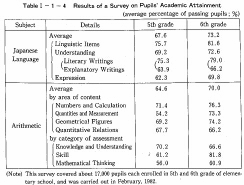
Because of excessive competition in entrance examinations, lower and upper secondary schools are forced to arrange their education always with entrance examinations in mind. Teachers, students and parents are all driven into the intense competition of entrance examinations and affected by considerable stress. Sound education built on the basics and adequate career guidance sensitive to the individual needs of each student are now endangered by such a situation.
One of the expressions of this phenomenon is the increase in enrollment in Juku or private institutions / classes on school subjects outside the formal schooling system. According to a 1985 survey by the Ministry of Education, Science and Culture, 1.8 million pupils of elementary schools and 2.7 million students of lower secondary schools are attending or have attended juku, and these figures show a remarkable increase compared to the results of a previous survey. Excessive involvement in juku makes it difficult for pupils to aquire rich experiences appropriate to their level of development and it exerts undesirable influences on their personality development.
In Japanese society, there is a tendency to evaluate persons at various stages of life based on which level of school education one has completed and whether one has graduated from a "prestigious" school or not if the level of education completed is the same. Particularly, at an early stage of life before one reaches adulthood, excessive competition for earning a higher and prestigious career of schooling is prevailing. Evaluation of respective schools tends to be based solely on their academic achievements and uniqueness in their educational efforts does not receive proper assessment ; nor is there a holistic consideration or potential and aptitude of each student.
A common explanation for excessive value placed on the educational background of individuals is that there remains a practice where leading corporations often open their employment opportunities only to those who graduate from prestigious universities. Related to this phenomenon is a tendency, among Japanese people who live in a homogeneous society, to reject any evaluation standards other than quantitative results of objective academic examinations.
"Cramming" focused on entrance examinations is very problematic if education is to develop creative and unique personalities. Serious efforts by those concerned are called upon to correct the tendency of placing too much value on the educational background of individuals and to improve the selection system of new entrants.

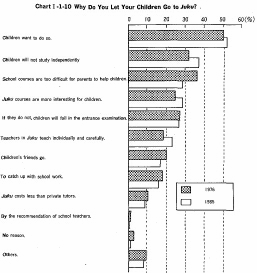
There has been no indication of decrease in problem behaviors such as delinquency, though their patterns have been changing.
Juvenile delinquency recorded peaks in 1951, 1964 and 1983, and has remained at a high level with slight declines. Juvenile delinquency today is characterized by the increase in the initial type of delinquencies such as shoplifting, the lowering of age of pupils committing delinquency and the prevailing of delinquency over a wider range of pupils. It has been an urgent problem to solve.
In the early 1980's many cases of student violence happened, and subsequently, bullying in schools became a serious social problem. Currently, however, the situation has become calm thanks to the joint effort of schools, families and local communities.
A new problem of refusal to attend school, however, has become serious. The number of pupils who refused to attend school in FY 1988 was about 6,000 for elementary school and about 36,000 for lower secondary school. These figures are the largest since this survey was started in 1966.
The modes of refusal to attend school vary widely ; some begin to refuse to attend school because they cannot accommodate themselves in the group life of schools ; some begin to refuse to attend school because they were bullied in schools ; and some do not attend by playing hooky or joining a delinquent group. The inducements for them to begin refusing to attend school are often difficult to be identified. Their causes are also difficult to be clarified in many cases. In order to solve this problem, the promotion of concerted action by schools, families and all the institutions concerned is indispensable.
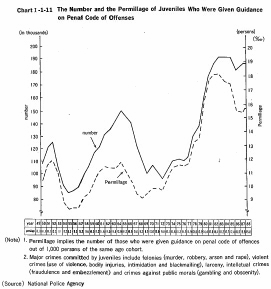
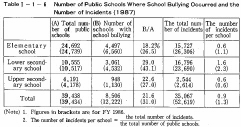
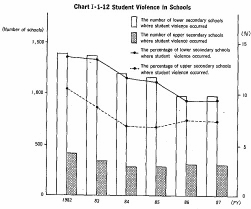
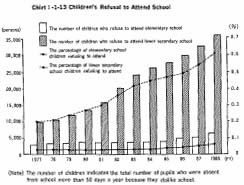
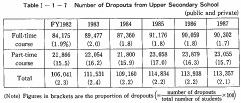
Behind these problem behaviors many factors are interlinked, which involve schools, families and society. Among them, the following points are noted.
1) Amid the prevailing tendency to place too much value on the educational background of individuals, only a single measurement tend to be employed to evaluate pupils at school. A well balanced education which develops individual traits, nurtures well-rounded personalities, and which builds a harmonious development of wisdom, virtue and body is not carried out satisfactorily.
2) Family education in teaching basic manners and customs of life is not carried out sufficiently.
3) Due to urbanization and other factors, opportunities to stay in touch with nature and to get involved in broad experiences of life are missing and also because of the decline of a collective social environment, opportunities to nurture independence and to form compassion to others are being lost.
In solving the problem of misconducts of pupils, it is necessary to plan the improvement and enrichment of overall educational environment in which pupils are placed. In so doing, the responsibility of schools as a special agency of education is overwhelming. Schools must improve learning instruction appropriate to each pupil, and must endeavor to provide guidance based on the full understanding of each pupil.
No less important is the problem of dropout from upper secondary schools than the refusal to attend school at elementary and lower secondary levels.
Dropouts from upper secondary schools numbered 110,000 in 1987. This figure has remained stable since the survey on dropouts was initiated in 1982. Many cases report, as reasons for dropping out, changes in career plans, maladjustment to school life and study, and poor academic performance. The causes and backgrounds of dropout cases somewhat resemble those of problem behaviors. Recent follow-up surveys on upper secondary school dropouts indicate that about a half of them either resumed school or intended to resume attendance at some school. Thus, further enrichment of instruction and guidance at upper secondary schools is most strongly needed, including the improvement of career guidance and the strengthening of learning instruction for pupils to fully understand learning content.
| Back to Top | MEXT HOME |